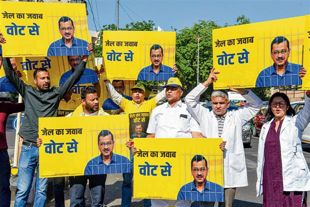
Sushil Manav in Chandigarh
Ajit Singh owns 8 acres in a village in Fatehabad district of Haryana where he grows cotton and wheat in the two crop seasons. After meeting the input costs, the Rs 50,000 per acre (approximately) that he earns as profit is hardly enough for his family to sustain. There is no way in which he can pay back the loan of Rs 4.5lakh he took for a tractor two years back. Ajit Singh’s is not an isolated example.
A large majority of Haryana farmers having less than 20 acres would identify with him. The condition of marginal and small farmers having less than 5 acres is even worse.
Dwindling landholdings due to division among siblings, high input costs, lack of remunerative prices, high risk involved in agriculture, increase in spending on farm machinery as also on lifestyle items are collectively leading to distress among farmers.
Input costs in agriculture have risen steeply in the past one decade. Not long ago, price of diesel, which is needed for running farm machinery, would be half the rates of petrol. But, over the years, the Centre as well as the state government have taxed diesel so heavily, it has sent the price spiralling. Same is the case with fertilisers and seeds, whose prices have risen steeply in the past one decade.
Gurnam Singh Charuni, president of the state unit of the Bhartiya Kisan Union, says that prices of farm produce are not increasing in proportion to the rise in prices of inputs and other commodities. He says that it is not merely the farm inputs that have gone dearer, every day necessities have become costlier too. “In 1967, if a farmer was to purchase bricks for the construction of his house, he would get 1,600 bricks for a quintal of wheat, but today, he gets merely 350 bricks for the same,” Charuni adds.
Similarly, the Bhavantar Bharpai Scheme launched by the Haryana Government for vegetable growers has also not been very successful as 504 farmers got just Rs 12 lakh as compensation during the first year of its implementation.
Purchasing tractors as a symbol of status rather than utility is also proving a bane for farmers. Unless a farmer owns a minimum of 20 to 25 acres, buying a tractor does not become financially viable. However, the tractor seems to be more of a status symbol than a utilitarian item. “No one will marry their daughter into our family unless we have one parked in our courtyard,” says a farmer. While some wise farmers have been able to break even by renting out their tractors, many consider this below their status, landing themselves in trouble.
Even though every political party in Haryana portrays itself as a great champion of the farmers’ cause, no one has ever tried to go deeper into the agrarian crisis and suggest solutions to revive farm economy. Most political parties have been parroting the same panacea of farm loan waiver, cheaper electricity and more generous MSP. The problem is the lack of political will that stops politicians from getting to the root of the cause and solve agrarian crisis.



























